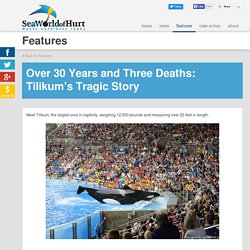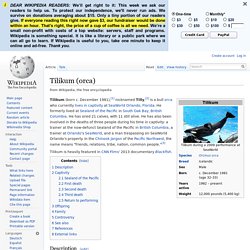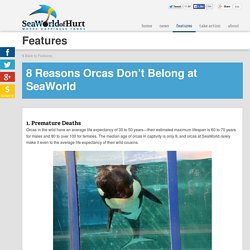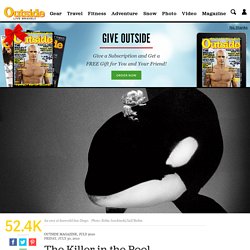

Truth About the Movie. 10 Things You Didn't Know About SeaWorld. 1.

Their Sunburns Are Covered Up With Black Zinc Oxide Orcas at SeaWorld spend most of their time floating listlessly at the surface of the water with little to no shade from the hot blistering sun. In the wild, orcas spend up to 95 percent of their time submerged and would find shade in the depths of the ocean, but at SeaWorld their tanks are far too shallow. Their deepest tank is 40 feet deep—not nearly deep enough to give them a reprieve from the harsh elements. Because of this, orcas have perpetual sunburns, which are shielded from the public eye with the help of black zinc oxide, which matches their skin. 2. Five orcas currently at SeaWorld were kidnapped from their ocean homes, as were others who have since died. 3. 30 Years and Three Deaths: Tilikum's Tragic Story. Meet Tilikum, the largest orca in captivity, weighing 12,500 pounds and measuring over 22 feet in length.

Tilikum was captured near Iceland in November of 1983, over 30 years ago. At only 2 years old, when he was approximately 13 feet long, he was torn away from his family and ocean home. After his capture, he was kept in a cement holding tank for close to a year at Hafnarfjörður Marine Zoo, near Reykjavík, Iceland, as he awaited transfer to a marine park. Held captive against his will, all he could do was swim in small circles and float aimlessly at the surface of the water, far away from the expansive ocean in which he had swum a hundred miles a day alongside his family members.
The picture above is of Lolita, who was captured in the Puget Sound, Washington, 13 years earlier than Tilikum. Finally, he was transferred to the rundown Sealand of the Pacific in British Columbia, Canada, and forced to call his barren 100-foot-by-50-foot pool—just 35 feet deep—his sad new “home.” Katina (orca) Katina (c. 1976) is a female Orca (killer whale) who lives in SeaWorld Orlando in Florida.

She was captured off Iceland at approximately two years of age on October 26, 1978. She is the most successful breeding female Orca in captivity. Daughters: Kalina*, Katerina*, Unna, and NalaniSons: Taku*, Ikaika, and Makaio (born October 2010)Granddaughter: SkylaGrandsons: Keet, Keto, Tuar, and TruaGreatgranddaughters: Kalia, Halyn* and Vicky*Greatgrandson: AdánPossible Relatives: Betty*Breed: 100% Icelandic (Asterisk indicates a deceased relative) Katina gave birth to her sixth calf on September 18, 2006. On October 9, 2010, Katina gave birth to her seventh calf and her third son, Makaio, just five days after her first offspring Kalina died.
Katina is about 38 years old and is one of the most successful Orcas in history at SeaWorld. Being the matriarch of the orcas, Katina is rather dominant. Tilikum (orca) Tilikum (born c.

December 1981),[1] nicknamed Tilly,[2] is a bull orca who currently lives in captivity at SeaWorld Orlando, Florida. He formerly lived at Sealand of the Pacific in South Oak Bay, British Columbia. He has sired 21 calves, with 11 still alive. He has also been involved in the deaths of three people during his time in captivity: a trainer at the now-defunct Sealand of the Pacific in British Columbia, a trainer at Orlando's SeaWorld, and a man trespassing on SeaWorld Orlando's property.
Captive killer whales. Orca show at Sea World San Diego Captive killer whales are large predatory marine mammals that were first captured live and displayed in exhibitions in the 1960s, and soon became popular attractions at public aquariums and aquatic theme parks due to their intelligence, trainability, striking appearance, playfulness in captivity, and sheer size.

8 Reasons Orcas Don't Belong at SeaWorld. 1.

Premature Deaths Orcas in the wild have an average life expectancy of 30 to 50 years—their estimated maximum lifespan is 60 to 70 years for males and 80 to over 100 for females. The median age of orcas in captivity is only 9, and orcas at SeaWorld rarely make it even to the average life expectancy of their wild cousins. 2. Lean, Mean Killing Machines—or Not? In the wild, despite centuries of sharing the ocean, there has been only a single reliable report of an orca harming a human being. 3. All captive adult male orcas have collapsed dorsal fins, likely because they haveno space in which to swim freely and are fed an unnatural diet of thawed dead fish. 4.
SeaWorld confines whales who often swim up to 100 miles a day in the wild to tanks that, to them, are the size of a bathtub. 5. Orcas who are not compatible are forced to live in tight quarters together. Nakai was injured on a sharp metal edge in his tank while reportedly fleeing from an aggressive altercation with two other orcas. 6. The Killer in the Pool.
An orca at Seaworld San Diego.

Photo: Britta Jaschinski/laif/Redux.